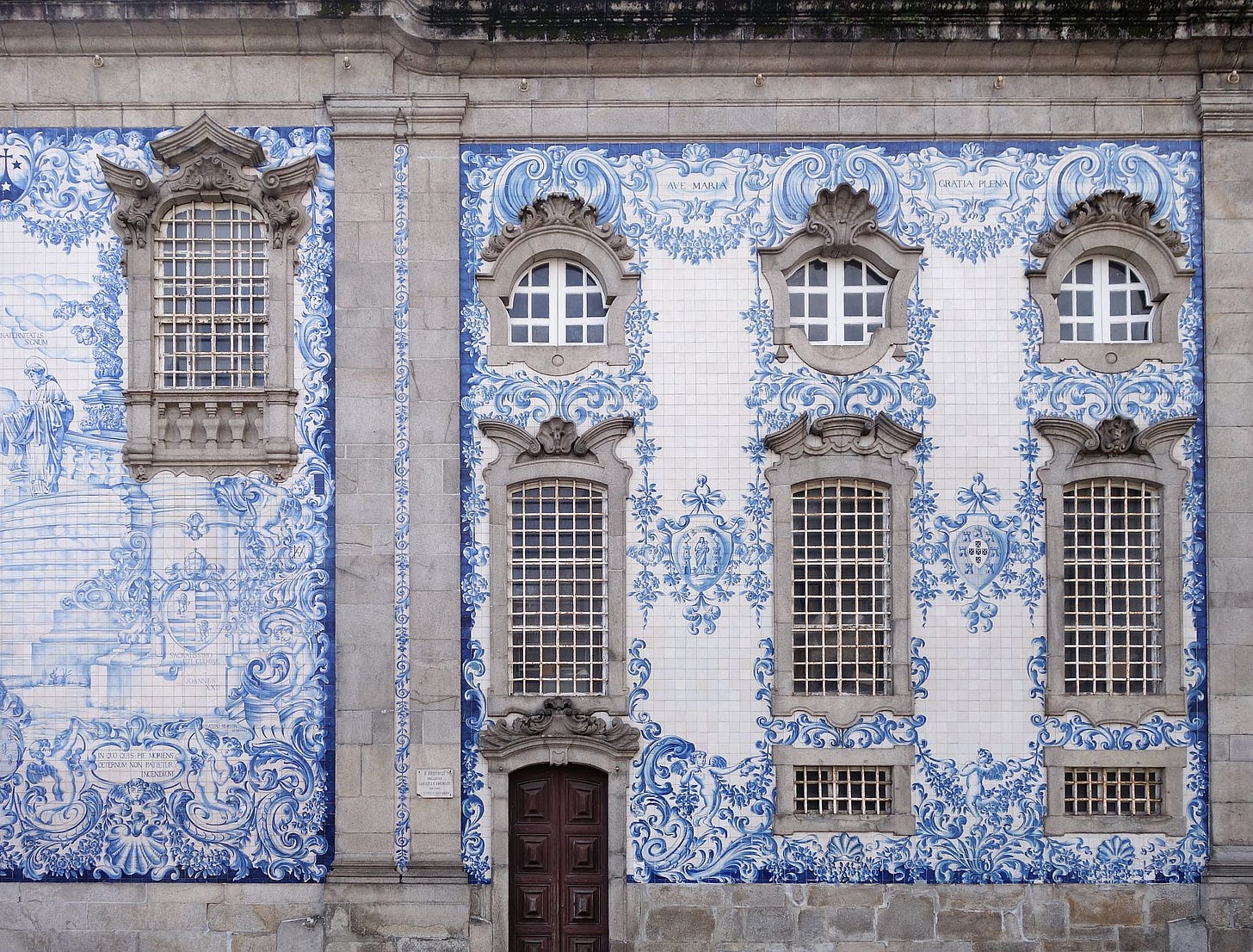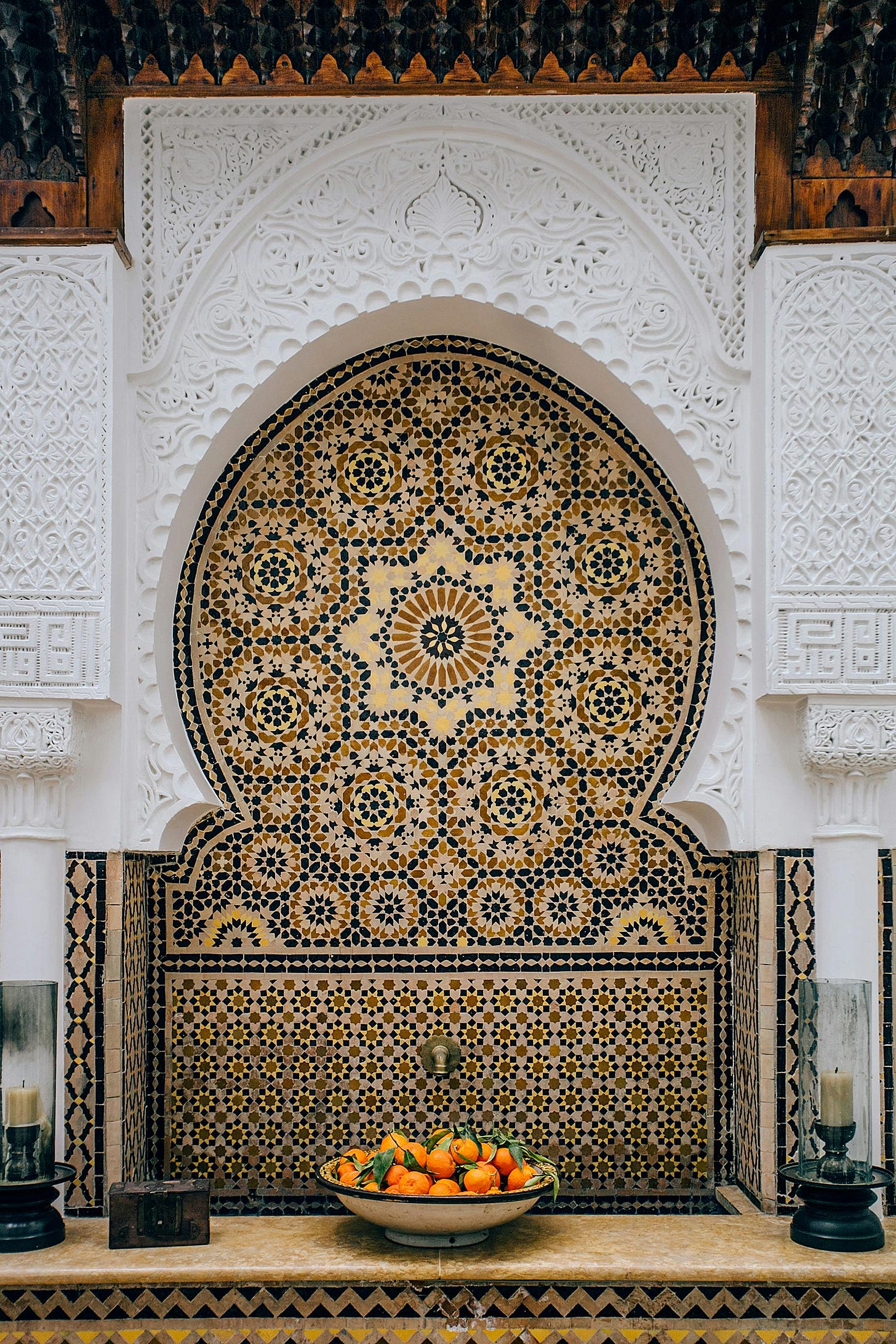Spend time in Portugal, and you’ll quickly notice the colorfully decorated tiles which adorn building facades and interiors across the country, especially in Portugal’s two largest cities, Porto and Lisbon. These are often arranged to form repeating geometric patterns, and also serve as the basis for stunning mosaics, with each piece an individually designed component of a sweeping narrative. The tiles have become internationally recognized symbols of Portuguese artistic expression.
So, aside from being pleasant to admire, why is it that Portugal has become so synonymous with the tiles? As it turns out, it has plenty to do with Portugal’s neighbors.

Creating Azulejos
Known as Azulejos (ah-zoo-le-zhoos), the tiles typically measure 5-6 inches square (bigger variants exist, but are far less common), and are designed and manufactured through a unique process.1

After baking the ceramics in an oven, artists spread each individual glaze color over a powder on the surface of the tile. Color is composed of a potent ink, diluted with water. After the glaze is applied, each individual piece is refired in an oven that often exceeds 1,000 degrees Fahrenheit. In addition to strengthening the tiles and making them resistant to rain, sun, and fire, this final step also reveals deeper hues in the glaze.2
Until recently, Azulejos were painted with colors based in metal oxides; green from copper, purple from manganese, white from tin, brown or orange from iron. Tilemakers would often be unable to view their creations in full color until they came out of the kiln. But the original paints were highly toxic, and eventually banned in the 1980s.3
Tiles of Al Andalus
From the Arabic, al-zulayj (or zellige), meaning, “little polished stone,” early versions of the Azulejos we know today appeared in southern Spain. Initially, many designs were produced in Seville or imported from Morocco. They started appearing in significant numbers in Portugal around the mid-13th century, near the end of Moorish rule.4
The Moors refer to an a Arabic-speaking Muslim caliphate from Africa, which conquered most of the Iberian Peninsula starting in 711 CE. This territory became known as Al Andalus (giving us the root for modern-day Andalusia for southern Spain).5
In practice, Europeans often used the term Moor to refer to Muslims in general, despite there being distinct political and ethnic identities throughout Africa and the Middle East.

After the Portuguese gained their independence and Moorish rule in the Iberian peninsula disintegrated, this tile industry took on a life of its own in Portugal and started to deviate from the original zellige.
Portuguese Innovation
Portugal imported most of its tiles from Spain until the middle of the 16th century, when a more homegrown industry started to develop. The elaborate mosaics visitors still see today probably reached their creative zenith in the Baroque period (~1675-1750), when the narrative-based mosaic style became enormously popular in churches and other public buildings.
This particular flavor of Azulejos, popular throughout the country, was also influenced by the Delft tiles being produced in the Netherlands.6 These in turn, were inspired by porcelain designs brought back from China by the Dutch East India Company in the 17th and 18th centuries.
It wasn’t just popular in Portugal — Azulejos designs made their way to far-flung outposts of a global Portuguese Empire, appearing in places like Brazil and Macau.7
Visit Porto’s São Bento Station, and you’ll be able to see a stunning array of mosaics in blue and white, made up of 20,000 individual tiles. Completed from 1905-1916 by Jorge Colaço, the artwork covers an area of over 550 square meters and depicts key events in Portuguese history.
Practical Use
In 1755, Portugal suffered a devastating earthquake which destroyed most of Lisbon. Incidentally, there is an enormous Azulejos depiction of the city which miraculously survived the quake. It serves as a pretty useful historical document, and a window into an era of Lisbon which has altogether disappeared.8
While they’re most famous for being installed on building exteriors, Azulejos are also used as accents for interior focal points or statement walls. They’re also commonly used in kitchens and bathrooms. In the case of Lisbon, Azulejos were used extensively in the reconstruction of the city, particularly for their conveniently fire-resistant properties.
Resurgence
Surprisingly, the use of Azulejos fell out of favor amongst the Portuguese elite and came to be viewed in a negative light in many circles during the late 19th and early 20th centuries. Many perceived them as relics from a bygone age, and practically despised them.9 This shift didn’t happen in a vacuum. Attitudes towards artistic embellishment were changing in Portugal, and across Europe.
Fortunately for us, Azulejos had the perfect opportunity for a popular revival in the mid 1950s. Developers of Lisbon’s first metro system sought a low-maintenance way for underground stations to feel less separate from the outside world. Azulejos offered an ideal solution. At least 19 stations on these lines were decorated by tiles designed by Maria Keil, whose husband was actually the architect for many of the line’s stations.
Porto and Lisbon are both veritable treasure-troves of Azulejos from 500 years of Portuguese history. But if you’re craving more tile art, you can visit the National Tile Museum (as of writing, still under renovation/reconstruction) which boasts a collection of over 17,000 unique tiles from across Portuguese history.
Terry Ward, "Discover the Story Behind Portugal’s Beautiful Azulejos," Herein by Marriott Residences, accessed May 17, 2024, https://herein.marriottresidences.com/portugal-azulejos/.
Dena Levitz, "To Get to Know Portugal, Explore Its Azulejo Tilework," Smithsonian Magazine, accessed May 29, 2024, https://www.smithsonianmag.com/travel/to-get-to-know-portugal-explore-its-azulejo-tilework-180980999/.
Vanessa Friedman, "Azulejo Tiles: The Art and Soul of Portugal," New York Times, April 1, 2024, https://www.nytimes.com/2024/04/01/fashion/azulejo-tiles-portugal.html.
Encyclopaedia Britannica, "Azulejo," last modified March 9, 2023, https://www.britannica.com/art/azulejo.
Encyclopaedia Britannica, s.v. "Moor," accessed May 29, 2024, https://www.britannica.com/topic/Moor-people.
Rosário Salema Carvalho, "Faith and Devotion: Reading the Ceramic Architectural Programs of the Baroque," Oxford Research Encyclopedia of Religion, accessed May 29, 2024, https://oxfordre.com/religion/display/10.1093/acrefore/9780199340378.001.0001/acrefore-9780199340378-e-904.
Friedman, "Azulejo Tiles."
Ward, "Discover the Story Behind Portugal’s Beautiful Azulejos."
Tariq Ali, "The Story Behind Lisbon's Beauty," BBC Travel, May 15, 2014, https://www.bbc.co.uk/travel/article/20140515-the-story-behind-lisbons-beauty.








I love this, Sean! I studied art history and Islamic art was a favorite topic. Maybe it was because I had a crush on the professor, but the tiles always appealed to me. Thanks for sending me the invitation. Welcome to Substack!
Why use tiles when you can have a brutalist concrete facade. The Portuguese had it all wrong, clearly.